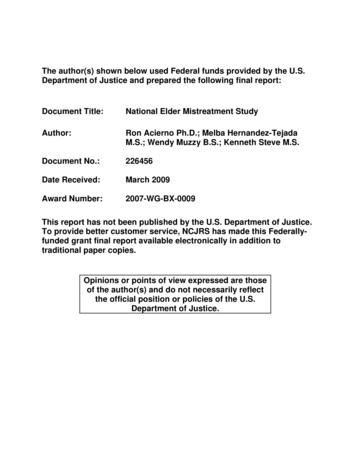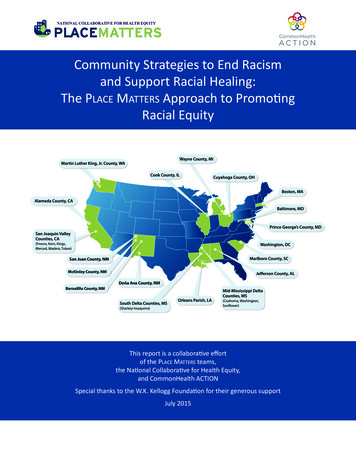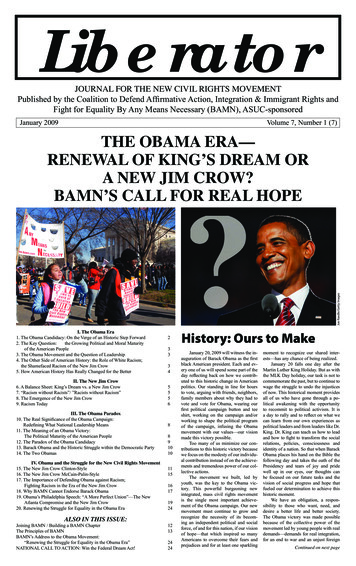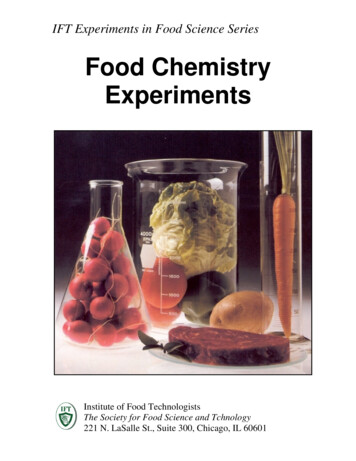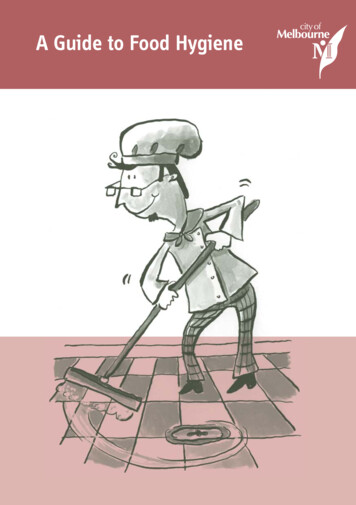
Transcription
Dismantling Racismin the food systemNumber 1, Winter-Spring 2016Special, multi-authored series on racism and liberation in the food systemFood—Systems—Racism: From Mistreatment to TransformationBy Eric Holt-Giménez and Breeze Harper*Racism—the systemic mistreatment of peoplebased on their ethnicity or skin color—affects allaspects of our society, including our food system.While racism has no biological foundation, thesocio-economic and political structures that dispossess and exploit people of color, coupled withwidespread misinformation about race, culturesand ethnic groups, make racism one of the moreintractable injustices causing poverty, hunger andmalnutrition. Racism is not simply attitudinal prejudice or individual acts, but an historical legacy thatprivileges one group of people over others.Racism—individual, institutional and structural (seeBox 3)—also impedes good faith efforts to build afair, sustainable food system.Source: Creative CommonsDespite its pervasiveness, racism is almost nevermentioned in international programs for food aidand agricultural development. While anti-hungerand food security programs frequently cite theshocking statistics, racism is rarely identified as thecause of inordinately high rates of hunger, foodinsecurity, pesticide poisoning and diet-relateddisease among people of color. Even the widely-hailed “good food” movement—with its plethoraof projects for organic agriculture, permaculture,healthy food, community supported agriculture,farmers markets and corner store conversions—tends to address the issue of racism unevenly.1Some organizations are committed to dismantlingracism in the food system and center this work intheir activities. Others are sympathetic but are notactive on the issue. Many organizations, however,see racism as too difficult, tangential to their work,or a divisive issue to be avoided. The hurt, anger,fear, guilt, grief and hopelessness of racism are uneasily addressed in the food movement—if they areaddressed at all.This Backgrounder is first in a series about howracism and our food system have co-evolved, howpresent-day racism operates within the food system, and what we can do to dismantle racism andbuild a fair, just and sustainable food system thatworks for everyone.*Eric Holt-Giménez, Ph.D. is the Executive Director of Food First. A. Breeze Harper, Ph.D., is Executive Director of The Sistah VeganProject www.sistahvegan.com, and Senior Diversity Analyst & Strategist (Ethical Consumption, Technology, Higher-Ed, and FoodSectors) Critical Diversity Solutions.This article benefited from the helpful comments of Alison Alkon, Ph.D. of University of the Pacific, Hank Herrera of the Center forPopular Education, Research and Policy, Inc., J. Miakoda Taylor of Fierce Allies, and Ana C. Galvis Martinez from Food First.1
Caste, Food and Capitalism“[It] was not the small farmers of the roughNew England countryside who established theUnited States’ economic position. It was thebackbreaking labor of unremuneratedAmerican slaves in places like South Carolina,Mississippi, and Alabama After the Civil War[and Abolition], a new kind of capitalism arose,in the United States and elsewhere. Yet thatnew capitalism—characterized first and foremost by states with unprecedented bureaucratic, infrastructural, and military capacities, and bywage labor—had been enabled by the profits,institutions, networks, technologies, and innovations that emerged from slavery, colonialism,and land expropriation.”The term racial caste describes a “stigmatized racialgroup locked into an inferior position by law andcustom.”2 Racial caste is one consequence of ahierarchical imbalance in economic, political andsocial power (sexism and classism are others). InNorth America and much of Europe, this racial castesystem privileges light-complexioned people ofNorthern European ancestry.Any country that has been subjected to Northerncolonialism has been structured by a racial caste system in which ‘whiteness’ concedes socialprivileges. This system was originally developed tojustify European colonialism and enable the economic exploitation of vast lands in the Americas,Africa, and Asia. Outright dispossession throughgenocidal military conquest and government treaties affected 15 million indigenous people—most ofwhom were farmers and lived in towns—throughout the period of US “westward expansion.” Colonization was largely carried out by white plantersand aspiring white smallholder-settlers.3The social justification for the commoditization ofhuman beings was the alleged biological inferiorityof the people who were used as property, and thedivinely-determined superiority of their owners.This division of power, ownership, and labor washeld in place through violence and terrorism. Italso required constant religious and scientific justification constructed on the relatively new conceptof “race.” Although enslaved peoples came fromethnically and culturally different regions of WestAfrica, they were classified as Black. Though slaveowners came from different areas of Europe wherethey had been known by vague tribal names likeScythians, Celts, Gauls and Germani, they were classified as White.In the Americas, Europeans and people of European descent murdered and dispossessed indigenouspopulations for their natural resources, sometimesenslaving them (e.g., the Spanish Catholic missionsand encomiendas). People from West African regions were enslaved, forcibly shipped across theAtlantic Ocean and sold as chattel to do backbreaking labor, primarily on sugar, tobacco and cottonplantations. While slaves acquired through war andtrade had been part of many societies for thousandsof years, widespread commerce in human beingsdid not appear until the advent of capitalism andthe European conquest.Slavery and colonization produced over a centuryof “scientific” misinformation that attempted toclassify human beings on the basis of their physicaltraits. Eventually, people were racialized into threemajor categories: Mongoloid, Negroid, and Caucasoid, with Caucasians awarded superior intelligence,The super-exploitation of enslaved human beingsphysical beauty and moral character. Scientistson plantations allowed slave systems to out-comargued over how to classify the many peoples thatpete agrarian wage labor for over two hundreddidn’t fit into these categories (such as the Finns,years. Under slavery, human beings were bought,Malays and most of the indigenous people in thesold and mortgaged as property. The tremendousAmericas). The messiness of the categories was unwealth generated from slavery was sent to northern important to the political and economic objectivesbanks where it was used to finance military conof racism. Systematically erasing the unique ethnic,quest, more plantations and ultimately, the industri- tribal, and cultural backgrounds of the world’s peoal revolution.4 The centrality of slavery and disposple while elevating a mythical Caucasian race was asession in the emergence of 19th century capitalism shameful exercise in egregiously bad science, butflies in the face of many myths about our foodit endured because it supported the control of thesystem (and capitalism). As Bekert 5 points out,world’s land, labor and capital by a powerful elite.62
Box 1: The birth and mutations of whitenessshortage. During WWII for example, when much ofthe US’s labor force was fighting in Europe and thePacific, the Mexican Farm Labor Program Agreementof 1942 imported Mexican peasants to keep theUS food system running. Without them, the UScould not have fought the war. After the war, theBracero Program brought in over 4 million Mexicanfarmworkers. Mexican labor was cheap andlegally exploitable. The “immigrant labor subsidy”transferred billions of dollars in value to the sector,turned WWII into a decades-long agricultural boonand transformed labor relations in agriculture.9From the beginning, the concept of race has beenfluid, constantly accommodating to the changingneeds of capital and the ruling class while undermining struggles for equality and liberation. Forexample, in the colonial Americas, there was littlesocial difference between African slaves and European indentured servants. But when they beganorganizing together against their colonial rulers,the Virginia House of Burgesses introduced theVirginia Slave Codes of 1705. These laws established new property rights for slave owners;allowed for the legal, free trade of slaves; established separate trial courts for whites and Blacks;prohibited Black people from owning weaponsand from striking a white person; prohibited freeBlack people from employing whites and allowedfor the apprehension of suspected runaways.Much later, during the early 20th century, poor,light-skinned Irish Catholic immigrants living inthe US were initially treated as an inferior raceand experienced discrimination as non-white. Asthe Irish began to organize for their rights—oftenacross racial barriers—they were steadily categorized as white, setting them apart politically—ifnot economically—from Black and indigenouspeople.7 Mediterranean people, some eastern Europeans and light-complexioned Latin Americanshave had similar experiences.But just as African-Americans are not recognizedfor their role in establishing the US as a nation (orcapitalism as its economic system), racial casteinvisiblizes the contribution of Mexican farmworkers to the US’s survival during WWII and stigmatizesMexican-Americans as citizens. Similar scenarioshave played out with Asian, Filipino and Caribbeanimmigrants. To this day, important sectors of thefood systems in the US and Europe continue to bedefined by dispossessed and exploited immigrantlabor from the Global South. Their systematicmistreatment is justified by the centuries-old racialcaste system.Racism in the Food SystemCalls to “fix a broken food system” assume thatthe capitalist food system used to work well. Thisassumption ignores the food system’s long, racialized history of mistreatment of people of color. Thefood system is unjust and unsustainable but it is notbroken—it functions precisely as the capitalist foodsystem has always worked; concentrating power inthe hands of a privileged minority and passing offthe social and environmental “externalities” disproportionately on to racially stigmatized groups.Slavery had a tremendous influence on food andlabor systems around the world and was the central pillar of capitalism’s racial caste system untilit was widely abolished in the late 19th century. Inthe US, after nearly three years of bloody civil war,the Emancipation Proclamation of 1863 releasedAfrican-Americans living in Confederate states fromslavery (though it took nearly two more years ofwar before ex-slaves could freely leave their plantations).8 The Thirteenth Amendment to the USConstitution finally put a legal end to slavery in theUS in 1865. But after a “moment in the sun” AfricanAmericans living in the former Confederacy werequickly segregated and disenfranchised through“Jim Crow” laws designed to maintain the racialcaste system in the absence of slavery.Statistics from the US confirm the persistence ofracial caste in the food system:African-Americans once owned 16 million acres offarmland. But by 1997, after many decades of JimCrow, several national farm busts and a generallyinattentive (or obstructionist) Department ofAgriculture (USDA), less than 20,000 Black farmersowned just 2 million acres of land.10 The rateRacial caste has systematically shaped the foodsystem, particularly during periods of labor3
economic burdens of diabetes and diet-related disease on low-income families of color aredevastating.of Black land loss has been twice that of whiteland loss and today less than 1 million acres arefarmed.11, 12 According to the USDA 2012 Census ofAgriculture, of the country’s 2.1 million farmers, only8 % are farmers of color and only half of those areowners of land. Though their farm share is growing(particularly among Latinos, who now numberover 67,000 farmers), people of color tend to earnless than 10,000 in annual sales, produce only 3%of agricultural value, and farm just 2.8% of farmacreage.13Trauma, Resistance and Transformation: Anequitable food system is possibleRecognizing racism as foundational in today’scapitalist food system helps explain why people ofcolor suffer disproportionately from its environmental externalities, labor abuses, resource inequitiesand diet related diseases. It also helps explain whymany of the promising alternatives such as landtrusts, farmers’ markets, and community supportedagriculture tend to be dominated by people whoare privileged by whiteness.18 Making these alternatives readily accessible to people of color requiresa social commitment to racial equity and a fearlesscommitment to social justice. Ensuring equity of access to healthy food, resources and dignified, livingwage jobs, would go a long way towards “fixing”the food system.While white farmers dominate as operator-owners,farmworkers and food workers—from field tofork—are overwhelmingly people of color. Most arepaid poverty wages, have inordinately high levelsof food insecurity and experience nearly twice thelevel of wage theft than white workers. While whitefood workers’ average incomes are 25,024 a year,workers of color make only 19,349 a year. Whiteworkers hold nearly 75% of the managerial positionsin the food system. Latinos hold 13% and Black andAsian workers 6.5%.14Box 2 Pedagogy of the Oppressed:The resulting poverty from poorly paid jobs isracialized: Of the 47 million people living belowthe poverty line in the United States, less than 10%are white. African-Americans make up 27% of thepoor, Native Americans 26%, Latinos 25.6% andAsian-Americans 11.7%.15“[The] great humanistic and historical task of theoppressed [is] to liberate themselves and theiroppressors as well. The oppressors, who oppress,exploit, and rape by virtue of their power, cannotfind in this power the strength to liberate eitherthe oppressed or themselves. Only power thatsprings from the weakness of the oppressed willbe sufficiently strong to free both. Any attempt to“soften” the power of the oppressor in deferenceto the weakness of the oppressed almost alwaysmanifests itself in the form of false generosity;indeed, the attempt never goes beyond this.In order to have the continued opportunity toexpress their “generosity,” the oppressors mustperpetuate injustice as well. An unjust socialorder is the permanent fount of this “generosity,”which is nourished by death, despair, and poverty.That is why the dispensers of false generositybecome desperate at the slightest threat to itssource.”19Poverty results in high levels of food insecurity forpeople of color. Of the 50 million food insecure people in the US 10.6% are white, 26.1% are Black, 23.7%are Latino and 23% are Native American.16 Evenrestaurant workers—an occupation dominated bypeople of color (who should have access to all thefood they need)—are twice as food insecure as thenational average.Race, poverty and food insecurity correlate closelywith obesity and diet-related disease; nearly half ofAfrican-Americans and over 42% of Latinos sufferfrom obesity. While less than 8% of non-Hispanicwhites suffer from diabetes, 9% of Asian -Americans,12.8% of Hispanics, 13.2 % of non-Hispanic AfricanAmericans and 15.9 % of Indigenous people havediabetes. At 245 billion a year, the national expensein medical costs and reduced productivity resultingfrom diabetes are staggering.17 The human andThe trauma of racism is inescapable. In addition tothe pain and indignity of racialized mistreatment,people of color can internalize racial misinformation, reinforcing racial stereotypes. While whiteprivilege benefits white communities, it can also4
immobilize them with guilt, fear and hopelessness.Both internalized racism and white guilt are sociallyand emotionally paralyzing, and make racism difficult to confront and interrupt.run by people of color and the spread of GrowingPower’s urban farming groups reflect a rise inleadership by those communities with the most atstake in changing a system that some have referredto as “food apartheid.” Oppressed communitieshave developed ways of healing historical traumaand there are peer counseling groups with skillsfor working through the immobilizing feelings ofinternalized oppression, fear, hopelessness andguilt. All of these resources and historical lessonscan be brought into the food movement.Difficult, but not impossible.Since before the Abolition movement and theUnderground Railroad of the mid-1800s, peoplehave found ways to build alliances across racialdivides. The history of the US food system is repletewith examples of resistance and liberation: fromthe early struggles of the Southern Tenant FarmersUnion to the Black Panther’s food programs and theboycotts and strikes by the United Farm Workers.More recently, the Food Chain Workers Alliancehave fought for better wages and decent workingconditions. The increase of local food policy councilsRacism still stands in the way of a “good foodrevolution.” If the food movement can begin dismantling racism in the food system—and within thefood movement itself—it will have opened a pathnot only for food system transformation, but forending the system of racial caste.Box 3 : Definitions Structural Racism: While most of the legally basedforms of racial discrimination have been outlawed,many of the racial disparities originating in variousinstitutions and practices continue and accumulateas major forces in economic and political structuresand cultural traditions. Structural racism refers tothe ways in which social structures and institutions,over time, perpetuate and produce cumulative,durable, race-based inequalities. This can occureven in the absence of racist intent on the part ofindividuals. Interpersonal Racism: This refers to prejudicesand discriminatory behaviors where one groupmakes assumptions about the abilities, motives,and intents of other groups based on race. This setof prejudices leads to cruel intentional or unintentional actions towards other groups. Internalized Racism: In a society where onegroup is politically, socially and economicallydominant, members of stigmatized groups, whoare bombarded with negative messages about theirown abilities and intrinsic worth, may internalizethose negative messages. It holds people back fromachieving their fullest potential and reinforces thenegative messages which, in turn, reinforces theoppressive systems. Racialization: This refers to the process throughwhich ‘race’ (and its associated meanings) is attributed to something – an individual, community,status, practice, or institution. Institutions thatappear to be neutral can be racialized, shaped byprevious racial practices and outcomes so that theinstitution perpetuates racial disparities, or makesthem worse. This is true of the criminal justicesystem, the education and health systems in ourcountry, and so on.20 Institutional Racism: Where assumptions aboutrace are structured into the social and economic institutions in our society. Institutional racism occurswhen organizations, businesses, or institutionslike schools and police departments discriminate,either deliberately or indirectly against certaingroups of people to limit their rights. This typeof racism reflects the cultural assumptions of thedominant group. “Reverse” Racism: Sometimes used to characterize'affirmative action' programs, but this is inaccurate.Affirmative action programs are attempts torepair the results of institutionalized racism bysetting guidelines and establishing procedures for5
and institutionalized mistreatment experienced bypeople of color at the hands of whites.finding qualified applicants from all segments ofthe population. The term 'reverse racism' is alsosometimes used to characterize the mistreatmentthat individual whites may have experiencedat the hands of individuals of color. This too isinaccurate. While any form of humans harmingother humans is wrong, because no one is entitledto mistreat anyone, we should not confuse theoccasional mistreatment experienced by whites atthe hands of people of color with the systematic Racial Justice: Racial justice refers to a wide rangeof ways in which groups and individuals struggle tochange laws, policies, practices and ideas that reinforce and perpetuate racial disparities. Proactively,it is first and foremost the struggle for equitableoutcomes for people of color.Useful linksUnlearning Racism: http://www.unlearningracism.org/Haas Institute for a Fair and Inclusive Society: http://haasinstitute.berkeley.eduCenter for Social Inclusion: http://www.centerforsocialinclusion.org/Grassroots Policy Project: http://www.strategicpractice.orgGrowing efood-system/dismantling-racism-resources/Black Lives Matter: http://blacklivesmatter.com/Endnotes1. Alison Hope Alkon, Black, White and Green: Farmers Markets, Race, and the Green Economy (Atlanta: University of Georgia Press,2012).2. Michelle Alexander, The New Jim Crow: Mass Incarceration in the Age of Colorblindness, Revised Edition (New York: The NewPress, 2012).3. Roxanne Dunbar-Ortiz, An Indigenous People’s History of the United States (Boston: Beacon Press, 2014).4. Edward E. Baptist, The Half Has Never Been Told: Slavery and the Making of American Capitalism (New York, NY: Basic Books,2014).5. Sven Beckert, “Slavery and Capitalism,” The Chronicle of Higher Education, December 12, 2014, 787/.6. Nell Irvin Painter, The History of White People (New York: W.W. Norton and Company, Inc., 2010).7. Noel Ignatiev, How the Irish Became White (New York, London: Routledge, 1995).8. Alexander, op. cit.9. Center for History and News Media, “Bracero History Archive,” 2014, http://braceroarchive.org/.10. Pete Daniel, Dispossession: Discrimination Against African American Farmers in the Age of Civil Rights (Chapel Hill: University ofNorth Carolina Press, 2013).11. Anuradha Mittal with Joan Powell, “The Last Plantation,” Backgrounder (Oakland, CA: Food First/Institute for Food and Development Policy, Winter 2000).12. john powell, “Poverty and Race Through a Belongingness Lens,” Policy Matters, Volume 1, Issue 5 (Northwest Area Foundation,April 2012).6
13. Eric Holt-Giménez, “This Land Is Whose Land? Dispossession, Resistance and Reform in the United States,” Backgrounder (Oakland, CA: Food First/Institute for Food and Development Policy, Spring 2014), eland/.14. “Food Insecurity of Restaurant Workers” (Food First, Food Chain Workers Alliance, Restaurant Opportunities Center, 2014), f-restaurant-workers/.15. Carmen DeNavas-Walt, Bernadette D. Proctor, and Jessica C. Smith, “Income, Poverty, and Health Insurance Coverage in theUnited States (2012)” (Washington, D.C.: US Census Bureau, September 2013) in The US Farm Bill: Corporate Power and StructuralRacialization in the United States Food System (Berkeley, CA: Haas Institute for a Fair and Inclusive Society, UC Berkeley, 2015), http://haasinstitute.berkeley.edu16. Elsadig Elsheikh and Nadia Barhoum, “Structural Racialization and Food Insecurity in the United States: A Report to the U.N.Human Rights Committee on the International Covenant on Civil and Political Rights” (Haas Institute for a Fair and Inclusive Society,UC Berkeley, August 2013).17. Centers for Disease Control and Prevention, “National Diabetes Statistics Report: Estimates of Diabetes and Its Burden in theUnited States, 2014.” (Atlanta, GA: US Department of Health and Human Services; 2014). ional-diabetes-report-web.pdf.18. Julie Guthman, “If They Only Knew: Color Blindness and Universalism in California Alternative Food Institutions,” in Taking FoodPublic: Redefining Foodways in a Changing World (New York, London: Routledge, 2012), 211–23.19. Paulo Freire, Pedagogy of the Oppressed (New York: Herder and Herder, 1970).20. Sandra Hinson, Richard Healey, and Nathaniel Weisenberg, “Race, Power and Policy: Dismantling Structural Racism” (NationalPeople’s Action, n.d.).Introduction to this special seriessystem, in the food movement, in our organizationsand among ourselves is fundamental to transforming the food system and our society.This Backgrounder is the first in a multi-authored series on “Dismantling Racism in the Food System.” Inthis series we seek to uncover the structural foundations of racism in the food system and highlightthe ways people, communities, organizations andsocial movements are dismantling the attitudes,institutions and structures that hold racism in place.Food First is convinced that to end hunger and malnutrition we must end injustices in the food system.Dismantling the injustices of racism in the foodFood First invites contributions on this topic fromauthors engaged in research and community actionto dismantle racism in the food system. Differentaspects of the topic can include land, labor, finance,food access, nutrition, food justice and foodsovereignty organizations.Food First is a “people’s think tank”398 60th Street, Oakland, CA 94618, USATel: 510.654.4400http://foodfirst.orgEmail: info@foodfirst.orgdedicated to ending the injustices that cause hunger and helping communities to take back controlof their food systems. We advance our missionthrough three interrelated work areas—research,education, and action—designed to promoteinformed citizen engagement with the institutionsand policies that control our food.Support us: donate -a-member/ 2016 Institute for Food and Development Policy/Food First/Food First Books.All rights reserved. Please do not copy without written permission from the publisher.7
light-skinned Irish Catholic immigrants living in the US were initially treated as an inferior race and experienced discrimination as non-white. As the Irish began to organize for their rights—often across racial barriers—they were steadily catego-rized as white, setting them apart politically—if not economically—from Black and indigenous
